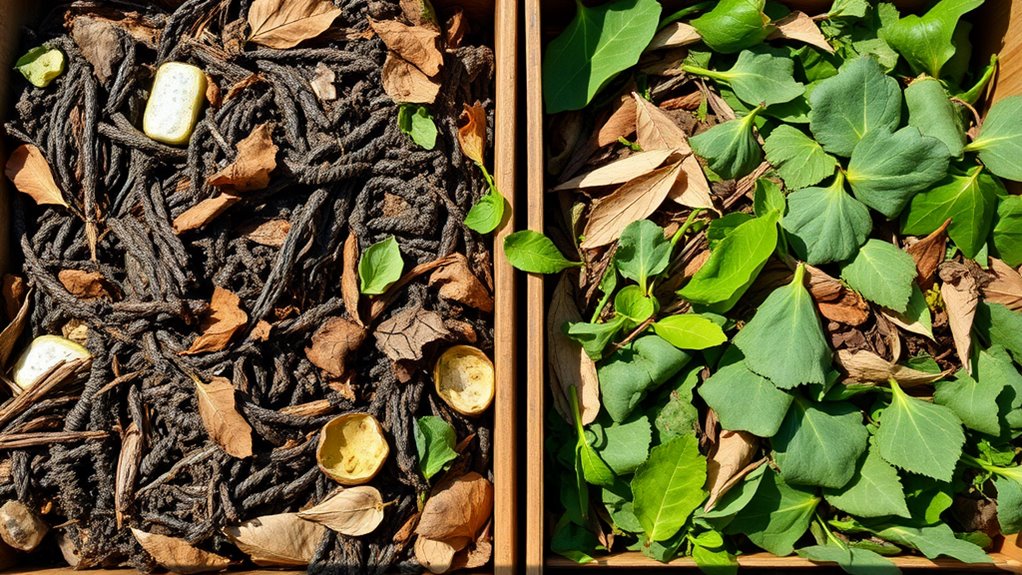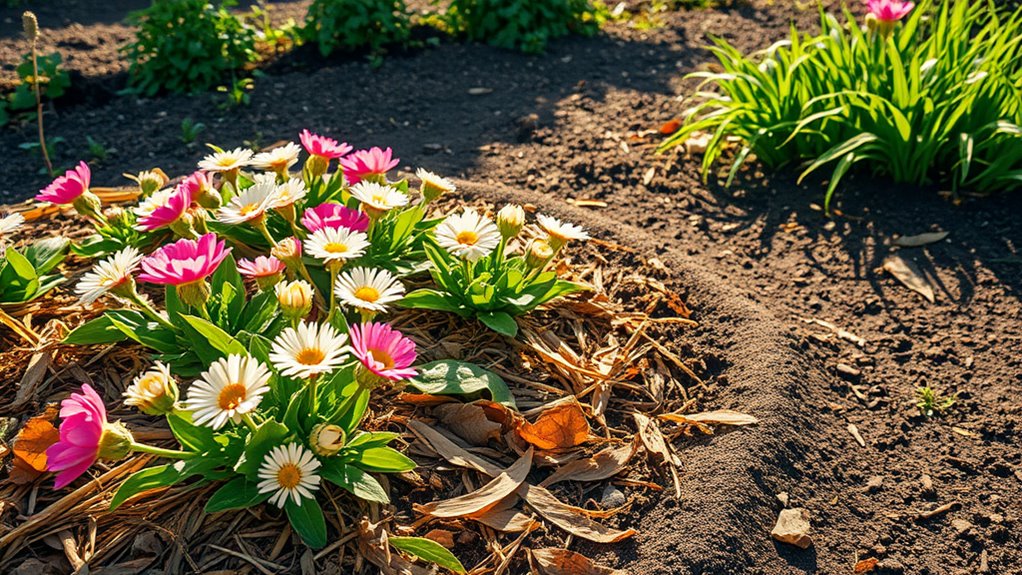My Weekly Compost Routine for Rich, Black Gold Soil
You kick off your weekly compost routine by gathering greens like kitchen scraps and browns like dry leaves, aiming for a 2:1 ratio to keep things balanced and odor-free. Prepare your bin with ventilation holes and a drainage layer, then layer materials evenly. Turn the pile weekly to aerate it, while checking temperature (130-160°F) and moisture (like a damp sponge). If odors or pests appear, add more browns or bury additions. Fine-tune these steps for even richer soil results.
Key Takeaways
- Collect brown materials weekly and mix with daily greens to maintain a 2:1 ratio for balanced decomposition.
- Turn the compost pile weekly to aerate it, promoting faster breakdown and preventing odors.
- Check the compost temperature weekly, targeting 130-160°F for optimal microbial activity.
- Monitor moisture levels weekly, adjusting to keep the pile at 40-60% for efficient composting.
- Troubleshoot issues weekly by adding carbon-rich materials if odors occur or watering if too dry.
Gathering Compost Materials
When you’re building a compost pile, start by gathering a mix of green and brown materials to create nutrient-rich soil.
Greens, including fruit and vegetable scraps, coffee grounds, and fresh grass clippings, provide essential nitrogen for microbial activity. Browns, such as dry leaves, straw, cardboard, and shredded paper, add carbon for aeration and structure. Recycling these materials also helps enhance soil health by promoting sustainable gardening practices.
In your easy composting routine, collect greens daily from the kitchen and browns weekly from the yard to maintain balance. Aim for a 2:1 browns-to-greens ratio to prevent odors and speed decomposition.
This simple habit ensures a steady supply, turning waste into valuable soil enhancer effortlessly.
By utilizing kitchen scraps effectively, you can transform your trash into garden gold that fosters healthier plants and a more sustainable garden.
Preparing the Compost Bin
Once you’ve gathered your compost materials, choose a bin that fits your space—whether it’s a simple plastic container, a wooden crate, or a tumbling model for easier turning. Additionally, incorporating a simple ingredient swap can enhance your composting efficiency.
Next, position it in a well-drained spot, like a shady garden corner, to prevent excess moisture buildup. Drill holes for ventilation if your bin lacks them, ensuring air flows freely to support decomposition.
Add a base layer of twigs or newspaper for drainage, and secure the lid to deter pests. Regularly check and clean the bin to maintain hygiene, making your composting routine efficient and effective.
Following these steps will help you produce that nutrient-rich black gold soil for your garden.
Balancing Green and Brown Layers
You need to balance green and brown layers in your compost to create nutrient-rich soil efficiently.
Start with an ideal green ratio of about 2:1—meaning twice as much brown material as green—to promote proper breakdown without excess moisture.
Follow these brown layer tips, like adding dry leaves or shredded paper, to aerate your pile and prevent odors.
By maintaining this balance, you can prevent common problems such as excess moisture or slow decomposition.
This approach not only optimizes your compost but also transforms kitchen scraps into nutrient-rich compost for enhanced garden health and sustainability.
Ideal Green Ratio
Achieving the ideal green to brown ratio, typically 2:1 or 3:1, ensures your compost pile decomposes efficiently and produces nutrient-rich soil. Greens, like vegetable scraps and grass clippings, provide nitrogen for microbial activity, while browns add carbon for balance. You’ll maintain this by layering greens more heavily—aim for two to three parts greens per one part browns—to avoid odors and speed up breakdown.
| Green Material | Benefits in Ratio |
|---|---|
| Vegetable Scraps | Boosts nitrogen for faster decomposition |
| Grass Clippings | Adds moisture and nutrients |
| Coffee Grounds | Enhances microbial growth |
| Fresh Leaves | Provides quick energy |
| Fruit Waste | Supplies acids for balance |
Brown Layer Tips
While balancing your compost pile’s green and brown layers is essential, effective brown material selection prevents excess moisture and promotes even decomposition.
You’ll want to use carbon-rich browns like dried leaves, straw, or shredded paper, aiming for a 2:1 or 3:1 brown-to-green ratio to avoid a soggy mess.
Chop larger items to speed up breakdown and ensure better airflow. Regularly layer browns over greens to maintain balance, checking moisture levels weekly—aim for a damp sponge feel.
This practice creates nutrient-rich soil while minimizing odors and pests, making your routine efficient and rewarding.
Turning the Compost Weekly
You’ll turn your compost weekly to maximize its efficiency, starting with understanding how this practice boosts aeration benefits by introducing oxygen that speeds up decomposition and prevents foul smells. This simple routine ensures you’re evenly mixing green and brown materials, which helps distribute moisture and nutrients for a more uniform breakdown. Even in small spaces, this method remains effective for beginners. By incorporating this into your routine, busy beginners can easily create nutrient-rich compost with minimal effort.
Aeration Benefits
Turning your compost pile weekly delivers key aeration benefits that enhance the entire process.
By regularly turning it, you’re infusing oxygen, which fuels aerobic microbes and prevents the pile from stagnating, leading to quicker breakdown and healthier soil.
-
Boosts microbial activity: Oxygen energizes beneficial bacteria, accelerating organic matter decomposition.
-
Reduces odors: Fresh air circulation minimizes anaerobic conditions that cause foul smells.
-
Speeds up composting: Aeration maintains optimal temperatures, shortening the time to rich soil.
-
Improves pile structure: It ensures even distribution, preventing compaction and promoting uniform results.
Mixing Techniques
Regularly mixing your compost pile weekly keeps it aerated and speeds up decomposition, so let’s dive into the best techniques for doing it right. To do this effectively, use a pitchfork to lift and turn materials, incorporating air while mixing green and brown layers thoroughly for even breakdown. This prevents odors and maintains moisture. If you’re dealing with a smaller pile, a compost tumbler offers easy rotation. Here’s a comparison of methods to emphasize their practicality:
| Method | Pros | Cons |
|---|---|---|
| Pitchfork | Deep aeration, low cost | Physically demanding |
| Tumbler | Quick and easy | Higher initial cost |
| Fork Mixing | Versatile for various piles | Requires more time |
Always check moisture after turning to keep your pile thriving.
Monitoring Temperature and Moisture
To maintain a healthy compost pile, you should regularly check its temperature and moisture levels, as these factors directly influence decomposition speed and nutrient quality.
You’ll use a compost thermometer to gauge heat, aiming for 130-160°F to kill pathogens and speed up breakdown. Keep moisture at 40-60% for optimal microbial activity—squeeze a handful to test.
-
Check temperature weekly: Insert a thermometer into the pile’s center; record readings to track trends.
-
Assess moisture levels: Grab a sample—if it’s like a wrung-out sponge, it’s ideal; adjust with water or dry materials.
-
Monitor changes daily: Observe variations after turning the pile to ensure balance.
-
Document findings: Keep a simple log to note temperatures and moisture, helping you maintain consistency over time.
By integrating these checks into your gardening routine, you can enhance sustainable practices for a thriving organic garden year-round.
Troubleshooting Common Issues
Even though you’ve monitored your compost’s temperature and moisture closely, issues like foul smells or overly dry piles can still crop up.
To fix foul smells, turn the pile immediately to aerate it and add carbon-rich browns, such as shredded leaves or cardboard, to balance excess greens and reduce anaerobic bacteria.
For an overly dry pile, sprinkle water evenly while mixing in nitrogen-rich materials like vegetable scraps, aiming for a moist, sponge-like consistency without sogginess.
If pests appear, bury fresh additions deeply under a layer of soil or dry leaves, and ensure no meat or dairy is included to deter them.
Regularly adjust these factors for smooth composting. This practice not only resolves issues but also enhances organic methods for achieving a more productive garden.
Additionally, incorporating your finished compost into your garden can help with eco-friendly weed control by enriching the soil and naturally suppressing weed growth.
Harvesting Nutrient-Rich Soil
When your compost pile has fully decomposed into dark, crumbly material, you’ll know it’s ready to harvest that nutrient-rich soil for your garden.
Check for an earthy scent and uniform texture to confirm maturity.
-
Use a garden fork: Gently turn the pile to access the finished compost without disturbing unfinished layers.
-
Sift for purity: Pass material through a 1/2-inch mesh screen to separate undecomposed bits, returning them to the active pile.
-
Weigh and assess: Measure your harvest to track yields, ensuring it’s moist but not soggy.
-
Store properly: Keep in a shaded, covered container to prevent nutrient loss until you’re set to use it.
Integrating Compost Into the Garden
Once you’ve harvested that nutrient-rich compost, you’ll want to incorporate it directly into your garden to boost soil fertility and plant health.
The best time is early spring or fall, when soil is workable. Start by tilling to a depth of 8-12 inches for aeration.
Spread a 1-2 inch layer evenly over beds, then mix it in thoroughly with a garden fork. For new plants, add a handful to planting holes; for established ones, use as mulch around bases.
Water immediately to activate nutrients. Test soil pH beforehand to adjust as needed, ensuring optimal uptake and preventing imbalances.
This enhances microbial activity, improves drainage, and promotes robust growth, turning your garden into a thriving ecosystem.
Additionally, combining compost with mulch can further improve moisture retention and support overall garden vitality.





